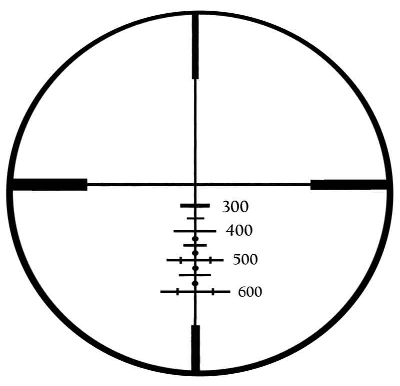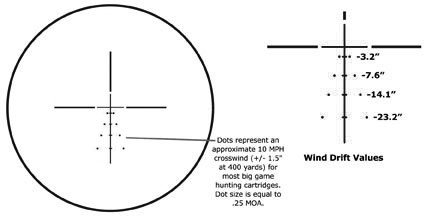


The “Ballistic Reticle” Scope: A Fixed Power Scope?
The last couple of years has seen the introduction of quite an assortment of ballistic reticle or hold-over type reticles. Along with that there has been some confusion about what they can do and what they can't do. Most hold-over type scopes are actually fixed scopes when used to compensate for range. One exception is the Pride Fowler Industries (PFI) “Rapid Reticle” series of scopes, that has the reticle in the first focal plane. A first focal plane reticle “always works,” as it changes in size in concert with magnification. This means that it is always proportional to the target size, so regardless of magnification the hold-over points are meaningful and useful.

Above, the Pride Fowler Industries "Rapid Reticle" 600-1 3-9 x 42 scope's reticle is in the first focal plane, so the holdover points are meaningful at all magnifications.
The vast majority of scopes sold in the United States have reticles in the second focal plane, meaning the reticle is a constant size. This is true of most hold-over reticles, so as they do not maintain proportionality to the target, they only work at one power. Another way of phrasing it is that the reticle does not scale with magnification. Your 3-9, 3-10, or 3-12 ballistic reticle is only a fixed power scope when that reticle is used. Normally cranked all the way up, nine, ten, or twelve power magnification is the only magnification where it works.
The negatives of this are several. If you don't have your power ring set properly, you can easily miss. In low-light situations or shooting off-hand, you may not want your scope cranked all the way up. Yet, all the way up is the only way if you want to use a holdover reticle.
Another consideration in hold-over reticles is compensating for wind drift. While gravity is wonderfully repeatable, wind speed and wind angle may vary all over the place. Without some type of easy to find hold point for windage, precise holding into the wind is not possible when you need it the most: at extended ranges. For that reason, the etched reticle found on the new Burris Fullfield E1 and Burris Six-X scopes makes perfect sense. Described as the “Ballistic Plex Enhanced,” you now have an easy, uncluttered way to compensate for wind drift.

Above, the Burris E1 reticle allows the shooter to quickly compensate for wind drift as well as range.
Ballistic reticle scopes can be of great value to the hunter. Yet, there are not always marketed transparently and accurately. Only a first focal plane reticle is accurate at all ranges, second focal plane scopes are fixed power scopes when their reticles are in use. Since this is the case, if you do choose a second focal plane scope, you might want to consider the magnification it is actually active at. A 9X scope might be far more valuable to you in a hunting scenario than a 12x or 14x scope, based on the smaller exit pupils with the same objective size, higher magnification, and the resultant lower low-light performance.
It is easy to be able to tell you what factory ballistics tables are accurate: that would be none of them. Temperature, barrel length, altitude, barometric pressure, your scope height from center of your rifle's bore . . . all of these factors affect exterior ballistics. There is no substitute for confirming your rifle at the ranges you intend to hunt at. No reticle can do that for you.
Links:
http://www.rapidreticle.com/Main/ScopeItem.aspx?ID=4&grpID=4
http://www.burrisoptics.com/fullfielde1.html
Copyright 2011 by Randy Wakeman. All Rights Reserved.


